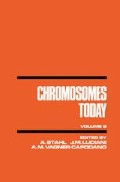Abstract
The transfer of foreign DNA into mammalian cells was first described by Szybalska and Szybalski (1962). Subsequent research by many investigators resulted in the development of selection systems for identification of DNA transformed cells. The discovery of covalent linkage between chromosomal DNA and DNA introduced by DNA-mediated transfer led to new approaches for gene mapping and studies of gene regulation in mammalian cells (reviewed in Pellicer et al., 1981). Theoretically, any type of DNA can be stably incorporated into chromosomes, including viral, prokaryotic and non-self (or self) eukaryotic DNA.
Access this chapter
Tax calculation will be finalised at checkout
Purchases are for personal use only
Preview
Unable to display preview. Download preview PDF.
References
Anderson, W.F. 1984. Prospects for human gene therapy. Science 226, 401–2.
Berg, P., A. Henderson, S. Ripley, J-K Yu and F. Anderson 1983. Lack of site-specific recombination in mouse L-cells. Biochem. Biophys. Res. Comm. 116, 959–65.
Eglitis, M., P. Kantoff, E. Gilboa, and F. Anderson 1985. Gene expression in mice after high-efficiency retroviral-mediated gene transfer. Science 230, 1395–98.
Heller, M., A. Henderson and E. Kieff 1982. A repeat array in Epstein-Barr virus is related to DNA sequences interspersed on human chromosomes. Proc. Natl. Acad. Sci. USA 79, 5916–20.
Henderson, A., M. Yu and S. Silverstein 1981. Chromosomal DNA homologous to Herpes simplex I virus in a mouse L-cell line. Cytogenet. Cell Genet. 29, 107–15.
Henderson, A. and D. Robins 1982. The effect of exogenous DNA insertion at a chromosomal region containing rDNA. Cytogenet. Cell Genet. 34, 310–14.
Henderson, A. 1982. Cytological hybridization to mammalian chromosomes. Int. Rev. Cytol. 76, 1–46.
Henderson, A., S. Ripley, M. Heller and E. Kieff 1983. Human chromosome association of Epstein-Barr virus DNA in a Burkitt tumor cell line and in lymphocytes growth-transformed in vitro. Proc. Natl. Acad. Sci. USA 80, 1987–91.
Henderson, A. 1983. Localization of viral-specific DNA in the mammalian chromosome complement by cytological hybridization. In Chromosomes and Cancer: From Molecules to Man, J. Rowley and J. Ultman, eds., 247–72. New York: Academic Press.
Hock, R.A. and A.D. Miller 1986. Retrovirus-mediated transfer and expression of drug resistance genes in human haematopoietic progenitor cells. Nature 320, 275–77.
Huberman, M., P. Berg, M. Curcio, J. DiPietro, A. Henderson and F. Anderson 1984. Fate and structure of DNA microinjected into mouse Ltk-cells. Exp. Cell Res. 155, 347–62.
Krumlauf, R., V. Chapman, R. Hammer, R. Brinster and S. Tilghman 1986. Differential expression of α-fetoprotein genes on the inactive X chromosome in extraembryonic and somatic tissues of a transgenic mouse line. Nature 319, 224–26.
Maniatis, T. 1985. Targeting in mammalian cells. Nature 317, 205–6.
McClintock, B. 1951. Chromosome organization and genic expression. Cold Spring Harb. Symp. 16, 13–47.
Palmiter, R. and R. Brinster 1985. Transgenic mice. Cell 41, 343–44.
Pellicer, A., D. Robins, B. Wold, R. Sweet, J. Jackson, I. Lowy, J. Roberts, G-K Sim, S. Silverstein and R. Axel 1980. Altering genotype and phenotype by DNA-mediated transfer. Science 209, 1414–22.
Robertson, M. 1986. Desperate appliances. Nature 320, 213–14.
Robins, D., S. Ripley, A. Henderson and R. Axel 1981a. Transforming DNA integrates into the host cell chromosome. Cell 23, 29–39.
Robins, D., R. Axel and A. Henderson 1981b. Chromosome structure and DNA sequences associated with mutation of transformed genes. Molec. Applied Genet. 1, 93–103.
Rogler, C. M. Sherman, D. Shafritz, J. Summers, T.B. Shows and A. Henderson 1985. Deletion of chromosome 11p associated with Hepatitis B integration site in hepatocellular carcinoma. Science 230, 319–22.
Savage, J. 1975. Classification and relationships of induced chromosomal structural changes. J. Med. Genet. 12, 103–22.
Smithes, O., R. Gregg, S. Boggs, M. Koralewski and R. Kucherlapati 1985. Insertion of DNA sequences into the human chromosomal β-globin locus by homologous recombination. Nature 317, 230–34.
Storb, U., K. Denis, R. Brinster and O. Witte 1985. Pre-B cells in K-transgenic mice. Nature 316, 356–58.
Szybalska, E. and W. Szybalski 1962. Genetics of human cell lines. IV. DNA-mediated heritable transformation of a biochemical trait. Proc. Natl. Acad. Sci. USA 48, 2026–34.
Thomas, K., K. Folger and M. Capecchi 1986. High frequency targeting of genes to specific sites in the mammalian genome. Cell 44, 419–28.
Williams, D., S. Orkin and R. Mulligan 1986. Retrovirus-mediated transfer of human adenosine deaminase sequences into cells in culture and into murine hemapoietic cells in vivo. Proc. Natl. Acad. Sci. USA 83, 2566.
Author information
Authors and Affiliations
Editor information
Editors and Affiliations
Rights and permissions
Copyright information
© 1987 The Organising Committee of the Ninth International Chromosome Conference, Marseille
About this chapter
Cite this chapter
Henderson, A.S. (1987). Chromosome accommodation to integration of foreign DNA. In: Stahl, A., Luciani, J.M., Vagner-Capodano, A.M. (eds) Chromosomes Today. Springer, Dordrecht. https://doi.org/10.1007/978-94-010-9166-4_2
Download citation
DOI: https://doi.org/10.1007/978-94-010-9166-4_2
Publisher Name: Springer, Dordrecht
Print ISBN: 978-94-010-9168-8
Online ISBN: 978-94-010-9166-4
eBook Packages: Springer Book Archive

